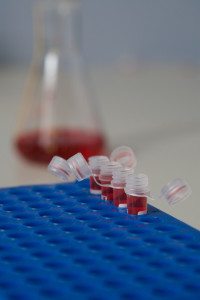Gonzalvo MC1, Gil F, Hernández AF, Villanueva E, Pla A. 1997
Abstract
 Inhibition of paraoxon hydrolase (paraoxonase) activity by ‘in vitro’ exposure to EDTA, Mg2+, Co2+, Ba2+, La3+, Zn2+, Cu2+, Hg2+, p-hydroxymercuribenzoate (p-OH-MB) and phenyl mercuric acetate (PMA) was investigated in human liver microsomes. Enzyme activity was totally inhibited by 1 mM EDTA in a time-dependent manner, in contrast to previous data obtained in rat liver where an EDTA-resistant fraction was detected. The possible influence of postmortem changes in these results was checked in a parallel experiment using rat livers with different postmortem intervals. From our results the existence in human liver of an EDTA-resistant fraction cannot be discarded. Ba, La and PMA showed immediate inhibition. By contrast the other compounds tested were time-dependent inhibitors. Ba and Zn showed the highest IC50 values. Cu and mercurials (Hg, p-OH-MB, PMA) were the most potent inhibitors of human liver paraoxonase. Kinetic analysis (Lineweaver-Burk and Dixon plots) indicated that different inhibitors exhibit different inhibition patterns: competitive (EDTA, Ba, La, Cu, p-OH-MB and PMA), non competitive (Zn) and mixed (Hg). The pretreatment of sample with dithiothreitol (DTT) protects against the inhibitory effect of mercurials. Furthermore after inhibition by mercurials the activity was restored by DTT. These results confirmed the essential role of the -SH groups to maintain the catalytic activity of paraoxonase and suggest the existence of two types of -SH groups that could differ in their localization.
Inhibition of paraoxon hydrolase (paraoxonase) activity by ‘in vitro’ exposure to EDTA, Mg2+, Co2+, Ba2+, La3+, Zn2+, Cu2+, Hg2+, p-hydroxymercuribenzoate (p-OH-MB) and phenyl mercuric acetate (PMA) was investigated in human liver microsomes. Enzyme activity was totally inhibited by 1 mM EDTA in a time-dependent manner, in contrast to previous data obtained in rat liver where an EDTA-resistant fraction was detected. The possible influence of postmortem changes in these results was checked in a parallel experiment using rat livers with different postmortem intervals. From our results the existence in human liver of an EDTA-resistant fraction cannot be discarded. Ba, La and PMA showed immediate inhibition. By contrast the other compounds tested were time-dependent inhibitors. Ba and Zn showed the highest IC50 values. Cu and mercurials (Hg, p-OH-MB, PMA) were the most potent inhibitors of human liver paraoxonase. Kinetic analysis (Lineweaver-Burk and Dixon plots) indicated that different inhibitors exhibit different inhibition patterns: competitive (EDTA, Ba, La, Cu, p-OH-MB and PMA), non competitive (Zn) and mixed (Hg). The pretreatment of sample with dithiothreitol (DTT) protects against the inhibitory effect of mercurials. Furthermore after inhibition by mercurials the activity was restored by DTT. These results confirmed the essential role of the -SH groups to maintain the catalytic activity of paraoxonase and suggest the existence of two types of -SH groups that could differ in their localization.
Full Text PDF: